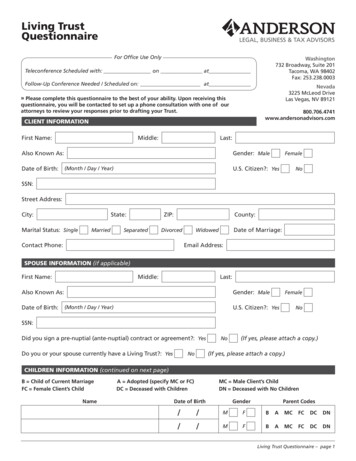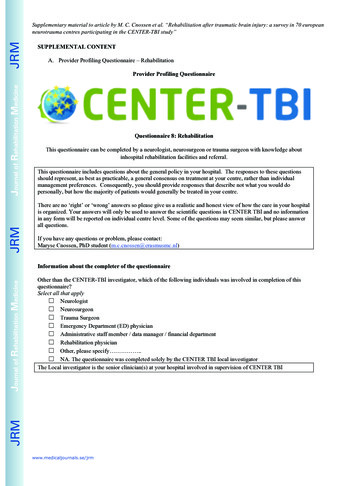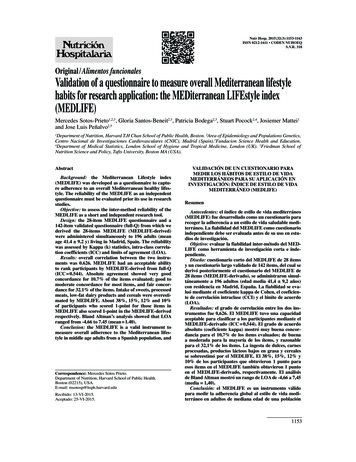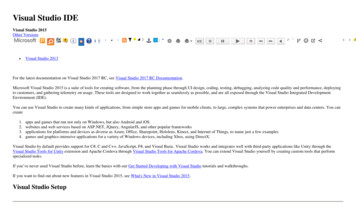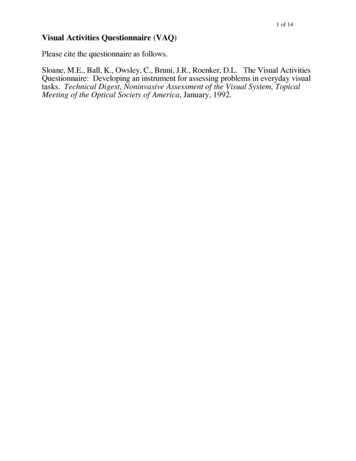
Transcription
1 of 14Visual Activities Questionnaire (VAQ)Please cite the questionnaire as follows.Sloane, M.E., Ball, K., Owsley, C., Bruni, J.R., Roenker, D.L. The Visual ActivitiesQuestionnaire: Developing an instrument for assessing problems in everyday visualtasks. Technical Digest, Noninvasive Assessment of the Visual System, TopicalMeeting of the Optical Society of America, January, 1992.
2 of 14VisualActivitiesQuestionnaire(VAQ)On the next few pages you'll read some statements about problems you mayencounter during activities which involve your vision. Read each statementcarefully. Then indicate how frequently you have the problem, by choosingthe one word beneath the statement that best applies to you and yoursituation. Please answer all the questions as if you were wearing yourglasses or contact lenses (if any).For example:I have difficulty seeing to drive at night.neverrarelysometimesoftenalwaysDO NOT DRIVELet's assume that after reading this statement, you decide that yousometimes have difficulty seeing things when you're driving at night.Therefore, on the line beneath this statement, you would put an "X" next tothe word sometimes to indicate that this is the word that best indicateshow frequently you have this problem. If you never drive, you would put an Xin the box marked DO NOT DRIVE.Please be sure to answer each question, taking as much time as youneed. All your answers are entirely confidential. In order for this survey toimprove our knowledge about vision problems and how they affect dailyactivities, your answers must be as accurate and candid as possible.Remember, if you wear glasses or contact lenses, please answer all of thefollowing questions as though you were wearing them.Please go to the next page and begin the questionnaire.
3 of 141. I have problems adjusting to bright room lighting, after theroom lighting has been rather dim.neverrarelysometimesoftenalways2. I have trouble noticing things in my peripheral vision.neverrarelysometimesoftenalways3. I have trouble finding a specific item on a crowded supermarketshelf.neverrarelysometimesoftenalways4. I have problems with lights around me causing glare when I'mtrying to see ys5. I tend to confuse colors.neverrarelysometimes6. I have trouble locating a sign when it is surrounded by a lot ofother signs.neverrarelysometimesoftenalways7. I have problems reading small print (for example, phone book,newspapers).neverrarelysometimesoftenalways8. I have trouble reading a sign or recognizing a picture when it'smoving, such as an ad on a passing bus or truck.neverrarelysometimesoftenalways
4 of 149. When pouring liquid, I have trouble judging the level of the liquidin a container, such as the level of coffee in a cup.neverrarelysometimesoftenalways10. I have trouble reading the menu in a dimly lit restaurant.neverrarelysometimesoftenalways11. I have trouble seeing moving objects coming from the side untilthey are right in front of me.neverrarelysometimesoftenalways12. It takes me a long time to adjust to darkness after being inbright light.neverrarelysometimesoftenalways13. When I'm driving, other cars surprise me from the side,because I don't notice them until the last moment.neverrarelysometimesoftenalwaysDO NOT DRIVE14. I have trouble driving when there are headlights from oncomingcars in my field of view.neverrarelysometimesoftenalwaysDO NOT DRIVE15. I have difficulty reading small print under poor lighting.neverrarelysometimesoftenalways
5 of 1416. I have problems locating something when it's surrounded by alot of other things.neverrarelysometimesoftenalways17. The color names that I use disagree with those that otherpeople use.neverrarelysometimesoftenalways18. I have problems carrying out activities that require a lot ofvisual concentration and attention.neverrarelysometimesoftenalways19. When I'm walking along, I have trouble noticing objects off tothe side.neverrarelysometimesoftenalways20. It takes me a long time to find an item in an unfamiliar store.neverrarelysometimesoftenalways21. Sometimes when I reach for an object, I find that it is furtheraway (or closer) than I thought.neverrarelysometimesoftenalways22. I have difficulty noticing when the car in front of me isspeeding up or slowing down.neverrarelysometimesoftenalways
6 of 1423. It takes me a long time to adjust to bright sunshine after Ihave been inside a building for a lengthy period of time.neverrarelysometimesoftenalways24. When driving at night, objects from the side unexpectedlyappear or pop up in my field of view.neverrarelysometimesoftenalwaysDO NOT DRIVE25. I have difficulty distinguishing between colors.neverrarelysometimesoftenalways26. I bump into people in a busy store because I have problemsseeing them in my peripheral vision.neverrarelysometimesoftenalways27. I have difficulty doing any type of work which requires me tosee well up close.neverrarelysometimesoftenalways28. I have trouble adjusting from bright to dim lighting, such aswhen going from daylight into a dark movie theater.neverrarelysometimesoftenalways29. When driving at night in the rain, I have difficulty seeing theroad because of headlights from oncoming cars.neverrarelyDO NOT DRIVEsometimesoftenalways
7 of 1430. When riding in a car, other cars on the road seem to be goingtoo fast.neverrarelysometimesoftenalways31. I find it difficult changing lanes in traffic because I havetrouble seeing cars in the next lane.neverrarelysometimesoftenalwaysDO NOT DRIVE32. I have problems judging how close or far things are from me.neverrarelysometimesoftenalways33. It takes me a long time to get acquainted with ase make sure that you have not skipped any items.Thank you for your cooperation!
8 of 14!!!Information about the Visual Activities Questionnaire (VAQ)Please refer to the summary of the VAQ (on following pages) for a discussion of its purpose,development, reliability and validity:On the first page of the VAQ are the instructions to the subject. These instructions are the oneswe used in developing the instrument, and also in our studies on older drivers. Depending on yourown application of the VAQ, you may want to revise these directions. However, users shouldkeep in mind that these are the directions used in establishing its reliability and validity, andchanges in the instructions could theoretically affect these psychometric properties. We chosethese particular instructions because the vast majority of our older adult subjects had no difficultyin understanding what they were asked to do. Users of the VAQ are also advised that changes inthe wording of the individual items could also affect the psychometric properties of the VAQ asdescribed in the attached summary. In addition, we have found that alternative wordings (e.g., "Xis more of a problem that it used to be") lead to uninterpetable data (e.g., for many older adults,most activities are more of a problem than they used to be).We selected a large, bold-face font for the individual items to enhance readability, since many ofour subjects have mild to moderate vision impairment. The VAQ was designed so that the subjectcan read it to him/herself and check off responses. However, on very rare occasions in our ownwork, the VAQ had to be orally administered by an interviewer because the subject was eitherilliterate or had severe vision impairment and could not see to read. In these cases, the interviewerread the items out loud to the subject, and then checked off the subject's responses as they wereorally communicated. Because this happened only infrequently, we have not systematicallyevaluated the differential effects of self- vs. oral-administration on VAQ performance.The instructions ask the subject to answer the questions "as if you were wearing your glasses orcontact lenses (if any)". The reason we use this wording is that we are interested in visualperformance problems the subject encounters as s/he routinely goes about everyday life. Mostsubjects who have glasses wear these glasses for routine activities, and thus it made sense to havesubjects address the items in this fashion. For example, most older adults who have readingglasses do indeed wear them for near tasks such as reading. Thus, in answering the questions onnear tasks, we wanted the subject to answer as if s/he had these glasses on. (In pilot testing anearlier version of the VAQ, we found that if we did not include the phrase "as if you were wearingyour glasses or contact lenses (if any)", then subjects were often confused about what we meant,and tended to respond to the items as if they were not wearing their habitual optical corrections.)Scoring the VAQ:Listed below are the eight areas of visual function evaluated by the VAQ, along with the itemnumbers from the VAQ which fall within each area. The VAQ's purpose is to generate acomposite score for each visual function area, which summarizes the subject's responses to theitems addressing that visual function. To score an individual item on the VAQ, the following
9 of 14scale is used: never 1, rarely 2, sometimes 3, often 4, always 5. If "do not drive" is checked,then that item is not considered further in computing the subject's composite score for that visualfunction. The composite score for a visual function is defined as the mean response for the itemslisted for that visual function.VAQ Visual FunctionsItems to be used to Compute Composite ScoreColor DiscriminationGlare DisabilityLight/Dark AdaptationAcuity/Spatial VisionDepth PerceptionPeripheral VisionVisual SearchVisual Processing Speed!!!!!!5, 17, 254, 14, 291, 12, 23, 287, 10, 15, 279, 21, 322, 11, 19, 26, 313, 6, 16, 20, 248, 13, 18, 22, 30, 33
10 of 14Reference Citation:Sloane, M.E., Ball, K., Owsley, C., Bruni, J.R., Roenker, D.L. The Visual Activities Questionnaire:Developing an instrument for assessing problems in everyday visual tasks. Technical Digest,Noninvasive Assessment of the Visual System, Topical Meeting of the Optical Society of America,January, 1992.The Visual Activities Questionnaire: Developing an Instrument for Assessing Problems inEveryday Visual TasksMichael E. Sloane1,2, Karlene Ball3, Cynthia Owsley2,1, John R. Bruni3, and Daniel L. Roenker31Dept. of Psychology2Dept. of Ophthalmology3Dept. of PsychologyUniv. of Alabama at BirminghamBirmingham, AL 35294Univ. of Alabama at Birmingham Western Kentucky Univ.Birmingham, AL 35294Bowling Green, KY 42101Introduction and BackgroundThis paper describes the development of a questionnaire for assessing an individual'sproblems in performing visual activities typical of everyday life. We were particularly interested inan instrument which would be useful with the elderly population, because eye disease is especiallyprevalent in this age group (Leibowitz et al., 1980), and even in the absence of significant eyedisease, older adults can still experience losses in visual function (Owsley & Sloane, 1990). Thistype of instrument could be useful from a number of perspectives. First, in many research settingsit is desirable to have some sort of metric for assessing the extent to which a subject is havingproblems in everyday visual tasks. Ideally it would be best to obtain performance measures on thevisual tasks under study, but the reality is that this is not possible in many studies. Thus, researchersoften resort to asking subjects about their self-perceived problems in performing the activity inquestion, but without a valid and reliable instrument, subjects' answers are often useless from ascientific standpoint. Examples of settings in which a psychometrically solid questionnaire might behelpful are: evaluating the effects of a treatment or procedure (e.g., cataract surgery) on visualfunctioning; assessing how self-perceived visual difficulties relate to an adverse outcome such as avehicle crash or a fall; and gathering information about visual tasks especially difficult for certainsubpopulations of older adults (e.g., those with age-related maculopathy). A second way aquestionnaire may be useful is in collecting epidemiological data on visual problems in the elderlypopulation. Epidemiological studies on eye health and visual functioning are costly, and from thestandpoint of actually carrying out the project, these studies are not particularly challenging orstimulating for research oriented clinicians (see Ederer, 1983). Coren and Hakstian (1987; 1988)have suggested that a suitably constructed questionnaire could be a much cheaper way to obtainsome types of epidemiological data. A third way in which a questionnaire instrument might beuseful is in developing hypotheses about the mechanisms underlying vision problems in the elderly.When visiting the laboratory or clinic, older adults often articulate visual problems, and aquestionnaire could provide them the opportunity to do so in a systematic fashion. Fourth, aquestionnaire might also be useful to clinicians since subjective information from the patient canyield clues about an undiagnosed disease process or condition.The first questionnaires or "inventories" designed to assess health and functional status inthe adult population did not specifically target visual problems (e.g., Maddox & Douglas, 1964;Bergner et al., 1981; Parkerson et al., 1981). But more recently, several instruments have beendeveloped that focus on vision. Coren and Hakstian (1987) developed an inventory for measuringvisual problems with three scales covering acuity, color vision, and binocular function. Theirquestionnaire had a number of positive features. Rather than asking for abstract judgments about thequality of the respondent's vision, questions were behaviorally based in that they asked aboutpotential problems in typical visual tasks ("Do you find most book print too small to read easilywithout glasses or contact lenses?" Five point response: Never to Always). The questions had goodvalidity when compared against actual laboratory tests of vision, with coefficients ranging from 0.59
11 of 14to 0.82. Internal consistency coefficients for each scale were also high, ranging from 0.86 to 0.94.Although this instrument appears to be based on sound psychometric principles, there are a fewreasons why it was not ideal for our purposes. First, it was evaluated with respect to young adultsonly, whereas our target population is the elderly. Second, they excluded individuals who reportedknowledge of specific visual problems as communicated to them by an eye care specialist. This wasdone so that the validation process was not confounded by information provided by a clinician, ratherthan being based exclusively on self-perceived problems in a visual task. However, in studying theelderly population, we are faced with the fact that most older adults do visit an eye care specialist andin many cases will be informed that they do have an ophthalmic condition. Furthermore, it seems tous that the validity coefficients of such an instrument should take into account the patient's beliefsabout his/her eye health. Third, the Coren and Hakstian instrument included questions on only 3aspects of vision, whereas we wanted to evaluate a wider spectrum of visual functions.Kosnik et al. (1988) developed a questionnaire for assessing problems in daily visualactivities. Consistent with our own goals, their instrument covered many aspects of visual function,used a behaviorally based question format, and was developed using an older adult sample.However, a close look at the Kosnik questionnaire indicated several potential problems. The mostserious problem was that the questionnaire can not be used to discriminate types of visual functionloss, i.e. most visual functions loaded on the same factor . In addition, the validity and reliability ofthe instrument were never established.In a recent abstract Mangione et al. (1991a) described a questionnaire called the "Activitiesof Daily Vision Scale". This instrument has five subscales which center on activities deemed to bevisually important and potentially difficult for patients with cataract (their population of interest).These activities include night driving, day driving, distance vision, near vision, and glare disability.They report that the instrument has high internal consistency reliability and criterion and contentvalidity. This scale has been used to evaluate improvements in older adults' ability to perform visualactivities following cataract surgery (Mangione et al., 1991b).We will now describe our own efforts to develop a questionnaire instrument for assessingolder adults' problems in everyday visual activities. Our goals were to develop a reliable instrumentwhich had criterion reference and construct validity and that did not require a lengthy period of timeto complete. Hereafter we will refer to our instrument as the Visual Activities Questionnaire, orVAQ.DevelopmentWe first identified ten target areas of visual functioning to be assessed by the VAQ: visionunder low illumination, peripheral vision, visual processing speed, visual search, acuity (both nearand distance tasks), color vision and contrast sensitivity, disability glare, light and dark adaptation,depth perception, and motion/dynamic sensitivity. These areas were selected since they are known tobe affected by the aging process and by various disease processes. After identifying these targetareas, we prepared ten questions in each of the ten areas. These items were not actually questions,but were phrased as statements (e.g., I have problems seeing when I'm driving at night"). Subjectshad to choose a response on a five point scale by indicating never/rarely/sometimes/often/always(scored 1 to 5). Items were behaviorally based in that they referred to actual visual activities andtasks, rather than to abstract visual capabilities. A given visual activity could be referred to in severaltarget areas. For example, the driving task makes use of a number of visual functions includingperipheral vision, glare sensitivity, and visual processing speed to name a few. Thus, questions ondriving were represented in several different target areas. We avoided wording such as "activity X ismore of a problem than it use to be", since this is almost always true for an older respondent.These 100 items were more items than we wanted to eventually incorporate into the finalVAQ, but this approach helped determine inter-item reliabilities so that we could eventually deleteitems which provided redundant information and which did not strengthen the group of itemsrepresenting a given visual function. Preliminary testing also permitted us to eliminate items withambiguous/confusing wording. In structuring the questionnaire, the items were presented within thequestionnaire in a constrained order. Items from the same visual function category (e.g., peripheral
12 of 14vision) and items asking about the same visual task (e.g., reading) were not presented in closeproximity to each other. This questionnaire was administered to 221 adults (mean age 55, range17 to 89) who were recruited through the Primary Care Clinic of the UAB School of Optometry andthe Vision Laboratory of Western Kentucky University (90% of sample was age 55 or over).Factor analysis was used to evaluate content validity and to determine which items groupedtogether on the basis of subject responses. Eight factors emerged and the following visual functionnames were applied to these factors: peripheral vision, acuity, visual search, depth, color, adaptation,glare, and processing speed. For each factor we identified which items within that grouping had thehighest correlation to the factor or "composite" score. (The composite score for a factor groupingwas defined as the mean response for the items in that factor.) To pare down the size of thequestionnaire, we then retained those items on the questionnaire which had the highest correlationwith the factor, and had the lowest correlations with the other factors. This procedure eventuallyresulted in an instrument one-third the length (33 items) of the original questionnaire. Table 1 liststhe correlations among the eight factor composite scores. The mean value and standard error of eachfactor composite is in the bottom row. The Cronbach alpha coefficients, which represent the internalconsistency reliability for each factor grouping of VAQ items, appear on the diagonal (inparentheses). All coefficients were high and exceeded 0.80. Our next step was to confirm thisfactor structure on a new sample of 314 older adults. This sample was recruited from the populationof licensed drivers aged 55 and over (mean age 72, range 56 to 98) who lived in Jefferson County,Alabama. The factor structure of the VAQ was verified with this sample, and the Cronbach alphacoefficients were similarly high on all eight factors (over 0.80). Thus the shortened version of theVAQ possessed similar psychometric characteristics as the original 100 question version, but wasmore practical since it required less time.The criterion validity of the VAQ was evaluated in two ways. First, a battery of actual visualfunction tests were carried out on a group of 294 subjects who also filled out the VAQ (shortenedversion). These individuals (mean age 71, range 56-90) were recruited from the population oflicensed drivers aged 55 years or over in Jefferson County, Alabama. (This is the same sample asdescribed in Ball et al., submitted manuscript, 1991). The tests administered consisted of: letteracuity, contrast sensitivity, stereoacuity, color discrimination, disability glare, processing speed,selective attention, size of the useful field of view, and visual field sensitivity (central 30 andperipheral 30-60). Because of space limitations, details about these tests are not presented here, buthave been previously described in Owsley et al. (1991) and Ball et al. (submitted). For each VAQfactor grouping, we computed the mean response for the entire sample on that factor grouping andthen divided subjects into two groups -- those falling within 2 standard errors of the mean ("noproblem" group) vs. those 2 standard errors away from the mean in the "negative" direction (i.e.those expressing difficulty with the tasks in question; "problem" group). We then compared the"noproblem" and the "problem" groups with respect to their performance on the various visualfunctional tests mentioned above. For most factors, those older adults who stated on the VAQ thatthey had difficulty with a given visual task, also tended to display a deficit in several aspects of visualfunctioning, when compared to older adults who stated on the VAQ they had no difficulty with thetask in question. (Performance in the disability glare test did not relate to any of the VAQ factorcomposites).Another way of examining the criterion validity of the VAQ is to examine the correlationsbetween each of the visual functional tests and the composite scores on each of the eight factorgroupings of VAQ items. These are listed in Table 2. Only significant r 's are listed. There are twonoteworthy features. First, most VAQ composites correlated with several aspects of visual function.This is not really surprising since the activity addressed in each VAQ item represents a complexvisual task which relies on many different aspects of visual function. Thus, it would be naive toexpect each composite to correlate with only one visual function. Second, for most of the eight VAQcomposites, the highest correlation typically occurred with a visual function test which measured akey aspect of the task in question. For example, the color composite correlated most highly withcolor discrimination ability (D-15); the acuity composite correlated most highly with measures ofspatial vision (acuity, contrast sensitivity, stereoacuity); the peripheral vision composite correlatedmost highly with visual field sensitivity. At first glance, the correlations in Table 2 may seem low,
13 of 14but we do not find them surprising. People base their opinions about whether they are having visualactivity problems on many sources of information, ranging from their expectations about what is"normal" for their age, to their obvious failures to perform a visual task successfully (e.g., bumpinginto obstacles during mobility). In addition, perceived social desirability can be a factor. Many olderindividuals place great emphasis on appearing socially "acceptable" and refrain from reporting theyhave a behavioral difficulty or health problem, fearing that they may appear "feeble". Thus, there area host of reasons why criterion validity on a vision questionnaire especially designed for older adultsis unlikely to be extremely high. The criterion validity of the VAQ (as listed in Table 2) iscomparable in magnitude to that reported for the Mangione et al. (1991a) instrument (0.37) .SummaryWe have developed a questionnaire instrument designed to assess the extent to which anindividual has problems in everyday visual tasks. The VAQ is especially designed for the older adultpopulation, who are at a higher risk for ocular disease and visual impairment than are younger adults.Our research indicates that the VAQ has good reliability, reasonable validity given the complexity ofself-report judgments about health and behavior problems, and is relatively brief to administer sinceit contains only 33 items. Our data indicate that older adults who report that they have visualdifficulties when administered the VAQ, tend to have visual deficits as measured by visual functionaltests. Therefore, the VAQ may prove to be a useful instrument in clinical and epidemiological visionresearch.ReferencesBall, K., Owsley, C., Sloane, M.E., Roenker, D.L., Bruni, J.R. (submitted manuscript, 1991) Paperavailable from authors.Bergner, M., Bobbitt, R.A., Carter, W.B., Gilson, B.S. (1981) Medical Care 19, 787-805.Coren, S., Hakstian, A.R. (1987) Applied Optics 26, 1468-1472.Coren, S., Hakstian, A.R. (1988) Perception and Psychophysics 43, 115-120.Ederer, F. (1983) Epidemiological Reviews 5, 51-66.Kosnik, W., Winslow, Kline, D., Rasinski, K., Sekuler, R. (1988) Journal of Gerontology 43, P63P70.Leibowitz, H.M. et al. (1980) Survey of Ophthalmology (Supplement) 24, 335-610.Maddox, G.L., Douglass, E.B. (1964) Journal of Health and Social Behavior 14, 87-93.Mangione, C.M. et al. (1991a) Clinical Research 39, 100A;.Mangione, C.M. et al. (1991b) Clinical Research 39, 604A.Owsley, C., Ball, K., Sloane, M.E., Roenker, D.L., Bruni, J. (1991) Psych. and Aging (in press,September issue).Owsley, C., Sloane, M.E. (1990) In F. Boller, J. Grafman (Eds.) Hndbk of Neuropsych. Vol 4.Elsevier, pp. 229-249.Parkerson, G.R. et al.(1981) Medical Care 19, 806-828.AcknowledgementsThis research was supported by NIH grants AG04212, EY06390, AG05739, and EY03039;the AARP Andrus Foundation; a Department Development grant from Research to PreventBlindness; and the Rich Retinal Research Foundation. We thank P. Alverson, M. Graves, M.Lewellen, and T. Threlkeld for assistance with data collection, and the UAB School of Optometryand the Alabama Department of Public Safety for help with subject recruitment. T. Threlkeld'sparticipation in this project was made possible by the NIH Minority High School Student ResearchApprenticeship Program (RR03001-09).
14 of 14Table 1: Correlations Among the Eight Factor Composite Scores, with Cronbach Alpha Coefficientsin Parentheses on the Diagonal. (Mean Composite Score and Standard Error of the Mean for thesample are in the last two rows.)Color(.86).39.46.43.49.57.59.54Glare Adapt Acuity Depth Periph Search SpeedColorGlareAdaptationAcuityDepthPeripheral VisionSearchProcessing 82)Mean Composite ScoreStand Error of .052.16.04(Note: Responsescale is 1 to 5;see text)Table 2: Correlations between the Visual Functional Tests and the VAQ Factor Composite Scores(Validity). Only significant correlations are listed (p .05). The disability glare test did not relate toany of the VAQ Factor Composites.Visual Function TestAcuityContrast SensitivityStereoacuityColor DiscriminationHumph Cen 0-30 degHumph Periph 30-60 degProcessing speedSelective AttentionUseful Field SizeVAQ Factor CompositesColor Glare Adapt Acuity Depth Periph Search 19.16.24
The Visual Activities Questionnaire: Developing an instrument for assessing problems in everyday visual tasks. Technical Digest, Noninvasive Assessment of the Visual System, Topical Meeting of the Optical Society of America, January, 1992. The Visual Activities Questionnaire: Developing an Instrument for Assessing Problems in Everyday Visual Tasks



